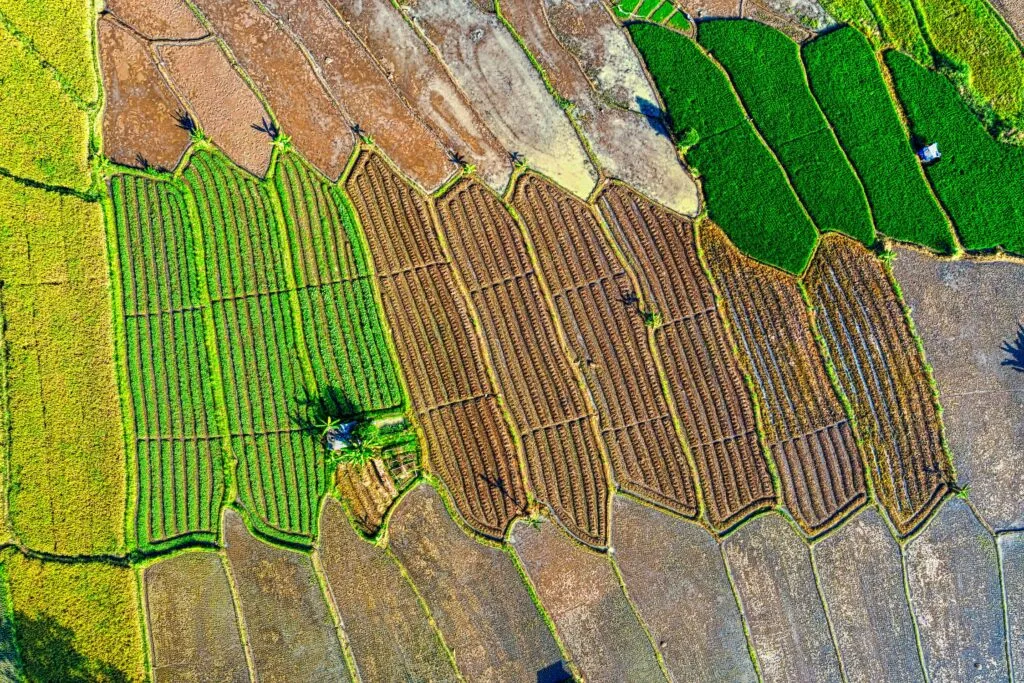
How Satellite Data is Contributing to Global Food Security
Editor’s note: This article was written as part of EO Hub – a journalistic collaboration between UP42 and Geoawesome. Created for policymakers, decision-makers, geospatial experts and enthusiasts alike, EO Hub is a key resource for anyone trying to understand how Earth observation is transforming our world. Read more about EO Hub here.
One in 10 people go to bed hungry each night, according to data from the UN’s World Food Programme. Globally, enough food is produced to feed every person on earth, but despite this, up to 811 million don’t have enough to eat. The number who can’t afford a healthy and nutritious diet is even more staggering: 3.1 billion, almost half the world’s population.
The situation is exacerbated by climate change, geopolitical tensions, and massive supply chain disruptions due to the COVID-19 pandemic—all of which tend to hit developing countries the hardest. The restrictions imposed by pandemic-driven lockdowns and travel bans, for example, were felt most strongly by low-income households, which simultaneously lost the ability to access markets as well as their own livelihoods.
In an episode of the Minds Behind Maps podcast on Food Security in Africa, Dr Catherine Nakalembe, Program Head of NASA Harvest Africa, makes the crucial point that access to food means both that the food is available and that it is not overpriced. “If there’s food at Whole Foods but I can’t buy it because it’s so expensive,” she explains, “I don’t have access to it.”
A new tool to support Global Food Security
Thankfully, technology is providing solutions to the food security crisis, and one of the most promising tools is remote sensing.
In fact, satellite data and advanced geospatial analytics have been used by various development institutions for some time. One of them is the World Food Programme (WFP), which is the world’s largest humanitarian agency, and one of the most advanced when it comes to using remote sensing in its operations. The agency and its local teams use both satellite and drone data, and it even has a dedicated task force—called Vulnerability Analysis and Mapping (VAM)—running the analysis.
The key focus for WFP’s local teams and the VAM platform is the use of Earth Observation data to monitor the impact of natural disasters, armed and political conflicts, extreme weather events, and other factors affecting agricultural production. They do this while also monitoring global and regional production levels to predict where problems may occur, enabling them to prepare accordingly. According to Dr Nakalembe, “Agricultural production is where remote sensing has a huge contribution.”
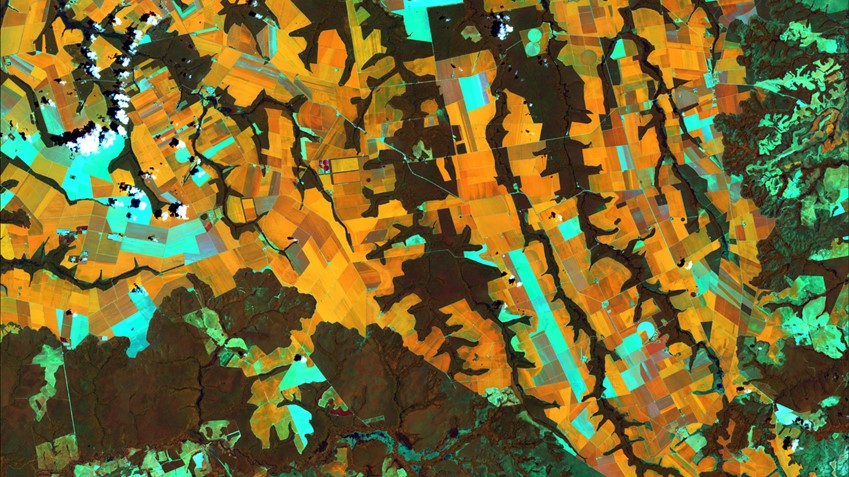
Satellite image of soy fields. source: https://www.cofcointernational.com/stories/satellite-images-play-major-role-in-building-sustainable-soy-supply-chain/
There are dozens of applications for remote sensing data when it comes to improving food security, from yield prediction to identifying environmental ‘hotspots’ or potential disaster areas.
The WFP uses different types of satellites to serve very specific purposes, with RGB imagery and multispectral data playing important roles. However, the most significant variable dictating which data will be applied to a specific use case is spatial resolution. Depending on that resolution, data can be used to provide a clear picture of various factors that could affect agricultural production or a disaster related risk in a particular area.
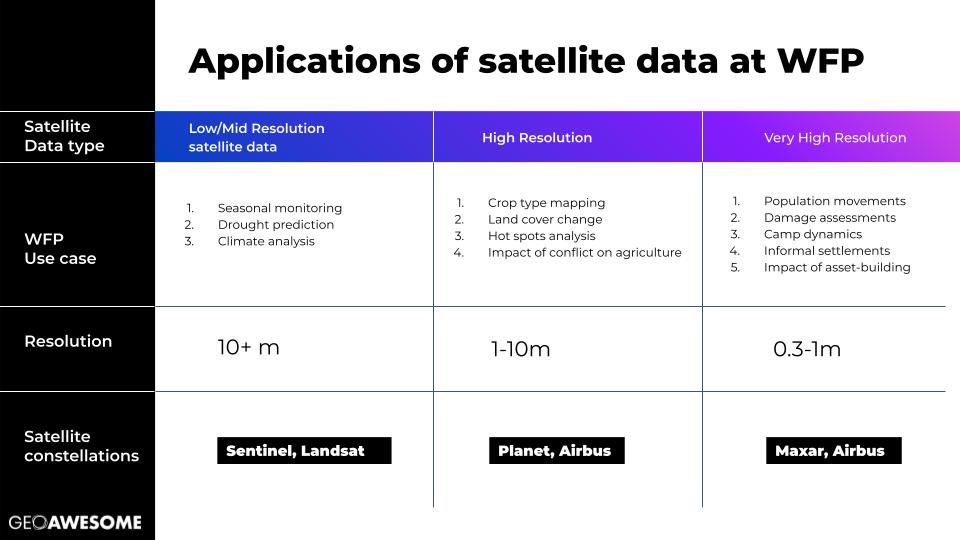
Applications of low–medium, high, and very high resolution satellite data
High-resolution data (between 1–10m) allows for detailed monitoring of changes to land use, crop type, and other hotspots, and is available from the Planet and Airbus constellations. Very high resolution imagery (below 1m), from Maxar and Airbus, can inform on population movement, settlements, infrastructure, and more.
Although many applications do require imagery at a high or very high resolution, the lower resolution, open-source data (from Sentinel and Landsat) can still be a powerful tool for providing a periodic overview of large areas of land or predicting climate conditions such as drought.
Seasonal Monitoring and Drought Prediction
One of the key applications of this type of climate data for the WFP is in its ‘Seasonal Monitor’, which analyzes the latest satellite data streams and seasonal forecasts to identify any developments that might be of humanitarian concern.
One of the most devastating factors when it comes to crop performance and yields is a prolonged period of drought. Early prediction of drought is therefore vital for the WFP and other organizations focused on food security, to help them anticipate how crops will perform throughout the current growing season and in future years.
In rural and impoverished areas, traditional methods of drought prediction are used, which usually comes down to in-situ physical rain gauges. These can be impractical, unreliable, and they only provide a relatively short-term forecast. Furthermore, all too often there simply aren’t enough of them—it’s easy to misinterpret data from a few isolated rainfall stations.
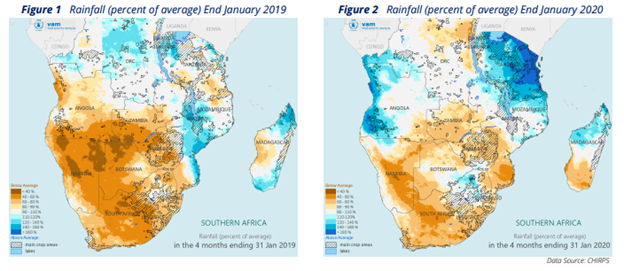
WFP uses data from CHIRPS (Climate Hazards Group InfraRed Precipitation with Station data) which combines information from local rain gauges with infra-red satellite data:
An even better early predictor of drought is to measure soil moisture, and it is now possible to do this from space. EUMETSAT’s Metop satellite carries an ‘Advanced Scatterometer’, which emits microwaves capable of penetrating several centimeters into the ground, where water molecules have the effect of ‘scattering’ the waves. The strength of the signal corresponds to the amount of water in the soil.
Satellite data provides better coverage, is more reliable, and gives more warning about impending drought than local gauges. The power of the technology is demonstrated by this chart of soil moisture levels in the Western Cape of South Africa, which clearly shows the strikingly dry conditions during 2017 compared with previous years:
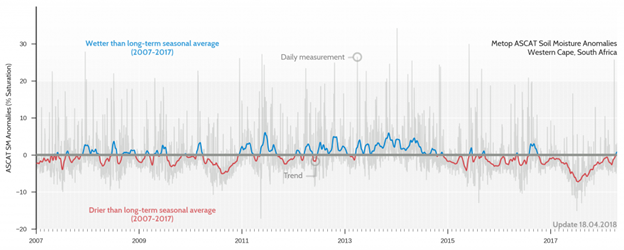
Soil moisture anomalies in Western Cape, SA — https://www.eumetsat.int/features/how-satellites-can-help-detect-impending-droughts
Remote Monitoring of Agricultural Production
To manage food security, it is vital that the WFP is first able to monitor agricultural production. By performing spectral analysis on satellite imagery, the organization is able to identify crops, assess growth, and predict eventual yields at harvest time. This method works by tracking the reflectance of the crop canopy throughout the growing season and using vegetation indices like NDVI to assess chlorophyll content—and it requires high-resolution data.
Satellite-based yield prediction has proven to be far more reliable than traditional methods in giving an accurate and early prediction of eventual yield, and is becoming increasingly relevant in managing food security. By mapping this data, the WFP (as well as other companies and organizations) can accurately forecast grain supplies and make contingency plans.
Specific information on crop health can also be combined with other data sources to provide further insights regarding agricultural production in specific areas. The data can help in terms of preparing crop rotation plans, mapping soil productivity, assessing crop damage, and more. In fact, one of the most important applications for the WFP is providing evidence to advocate for humanitarian intervention.
Recently, another UN body, the Commission on Science and Technology for Development (CSTD), partnered with China to make their ‘CropWatch’ system available to developing countries battling food insecurity. The international program will give developing countries the agency to monitor their own crops in real-time, as well as providing an infrastructure platform to enable them to analyze this data. The primary aim is to increase national food security, but the system can also be customized to meet the specific needs of individual countries, including achieving SDGs.
Beyond Crop and Climate Monitoring
Monitoring crop performance and climate conditions may be the most obvious applications for remote sensing and food security, but development institutions like the WFP are finding many more uses for satellite data.
For instance, very high resolution data can be useful in monitoring ‘hot spots’: large-scale environmental changes, whether positive or negative, which might have an impact on agricultural production. These are often caused by human activities, including population movement, informal settlements, and armed conflicts. Satellite imagery can be used to detect such hot spots and determine any changes that will specifically affect agriculture—for example, diversion of water sources or changes in land use.
Through very high resolution imagery, sufficient data can be gathered for organizations to make accurate predictions on what impact these situations might have on food production, whether any intervention is required, and whether food shortages are likely. For example, in 2019, the WFP was able to use satellite data to detect and measure abandonment of cropland in Mali:
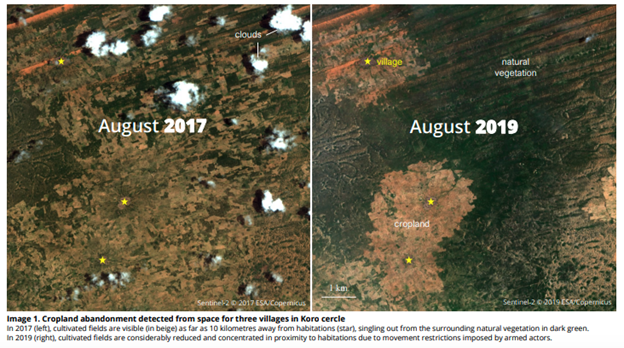
Other development institutions are increasingly turning to satellite data to inform and facilitate their activities, including infrastructure projects. For example, in 2016, Germany-based development bank KfW began financing the construction of an irrigation perimeter for the purpose of improving food security in Niger. The result was the creation of an area of wetlands which effectively tripled rice yield for around 8,000 smallholder farmers, each of whom supports a family of around 10 people, meaning 80,000 people have improved living conditions as a result of the improved irrigation.
However, in 2020, flash floods occurred across Niger, and there was a pressing need to assess the extent of any damage caused to the infrastructure by the flooding. Due to the challenging local conditions, exacerbated by travel restrictions imposed during the pandemic, the only option for assessing the damage was to use remotely-sensed satellite imagery, so
Following this, satellite data became a more permanent solution for KfW’s infrastructure monitoring challenges. The company has now established a dedicated geospatial information service, which provides data that can verify the implementation of financed projects and monitor impact, as well as aiding in the selection of adequate project sites, and ensuring that appropriate safeguards are in place throughout implementation.
The Challenge: Access to Data and Machine Learning
Development institutions and food security programs face a big challenge when it comes to satellite data: Although access to data has improved significantly over time with the use of platforms such as UP42, there is still a deficit when it comes to high-resolution data—as well as the processing and analytics resources required to work with it.
Data of the highest resolution is particularly useful, explains Jean-Martin Bauer, the WFP’s country director for Haiti, partly because it can be used in conjunction with other sources of data, and can thereby provide insights more accurately and rapidly. Unfortunately, this type of high-quality data is not easily available, and as a result the WFP primarily resorts to using open data from Sentinel and Landsat. “With the private companies […] cost is still a barrier,” Bauer says. “That data is still behind a paywall.”
There is a similar issue when it comes to the AI and machine learning technologies that are needed for data analysis to be performed at scale. Currently, to monitor events like natural disasters and their impact on food security, the WFP extracts data manually from both satellite and mobile phone imagery. Conducting this process takes considerably longer for a human than it would take an AI.
“I’d love to see an Open AI movement, where the satellite data itself and the libraries could be totally open for humanitarian purposes,” Bauer says. However, “that space has to be designed so that the private companies do not lose their competitive advantage.”
What’s Next for Satellite Data and Global Food Security?
Earth Observation data is already a critical tool in the ongoing quest for global food security. It gives us the ability to view vast areas, including those out of reach by conventional methods. It provides rich, multispectral information that can’t be seen from the ground or with the human eye, and where archive satellite data is available, it even gives historical context to aid in understanding baselines and geospatial dynamics.
Soon, development organizations will be provided with even more tools to aid the fight against hunger. NASA has been leading the way with research projects to improve our understanding of agricultural methods, offering insights for long-term agricultural planning—and, consequently, food security. One of their projects is the Harvest program in Thailand, which aims to understand the effects of land use change on biomass emissions and soil quality. Specifically, it assesses the effects of crop type and management practices, and their impact on soil carbon levels and general rural wellbeing. The data produced by the project is expected to be used to inform land use and policy on a regional scale—however, the hope is that the methodology could be extended to other developing countries in South Asia.
Another NASA project aims to create a prototype Cropland Carbon Monitoring System to improve existing methods of estimating carbon flux—the process by which carbon is absorbed, stored, released or transferred through various agricultural processes—and its environmental impact.
Satellite data is helping to save millions of lives each year, by providing development institutions with the tools they need to increase food security. However, there are significant areas for improvement. In an ideal world, the WFP and other organizations need access to datasets from private companies, as well as the advanced AI models which permit advanced data analysis, to make the most of the technology available. If that can be achieved—and what companies like UP42 are doing is certainly a step in the right direction—then anything’s possible.
Did you like the article? Read more and subscribe to our monthly newsletter!






